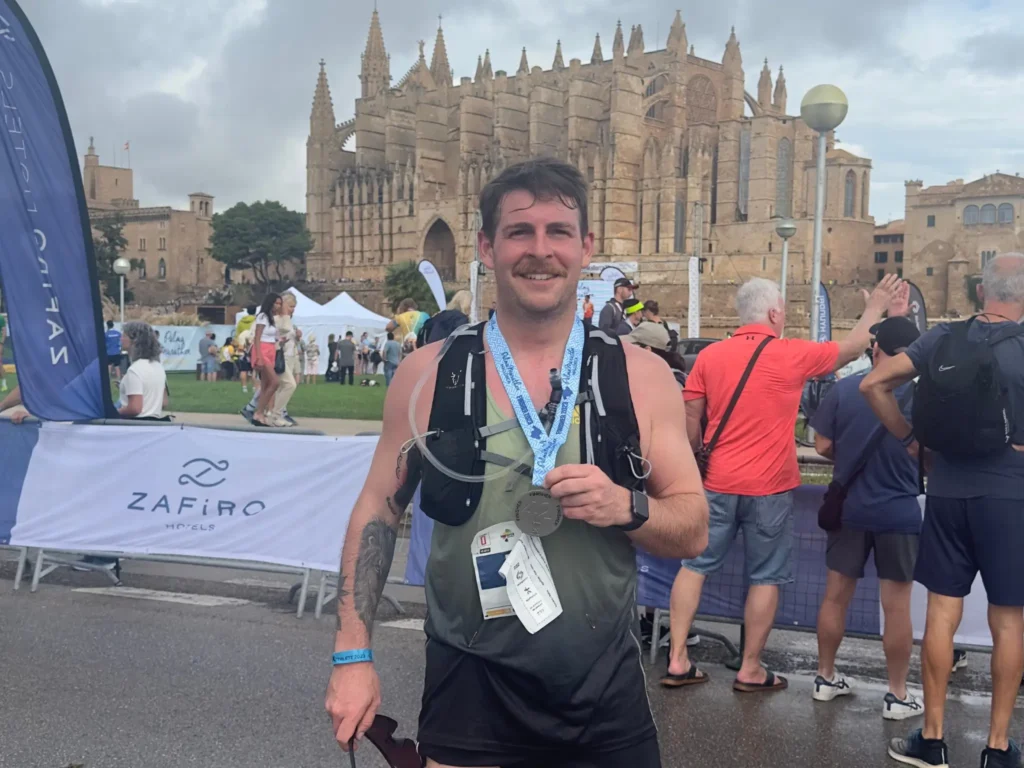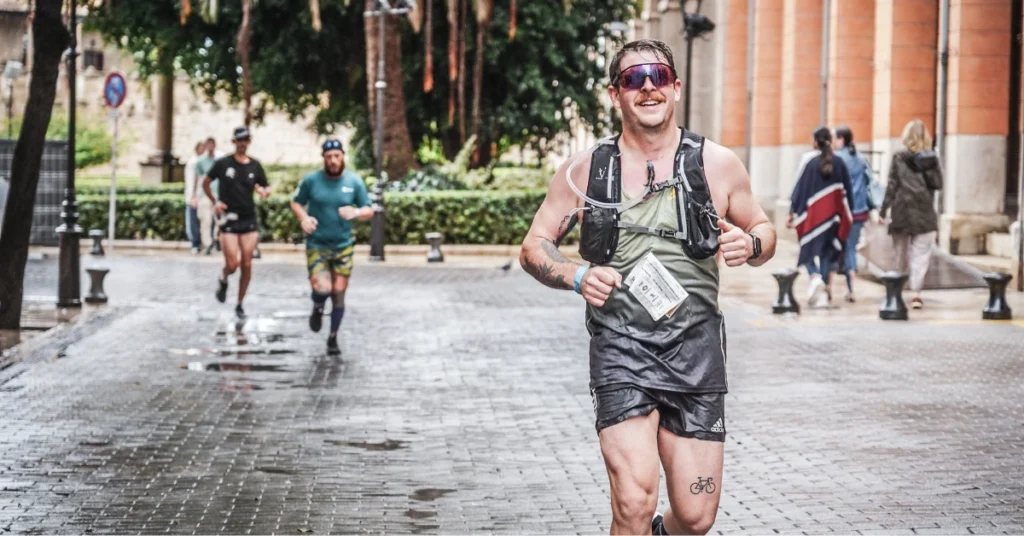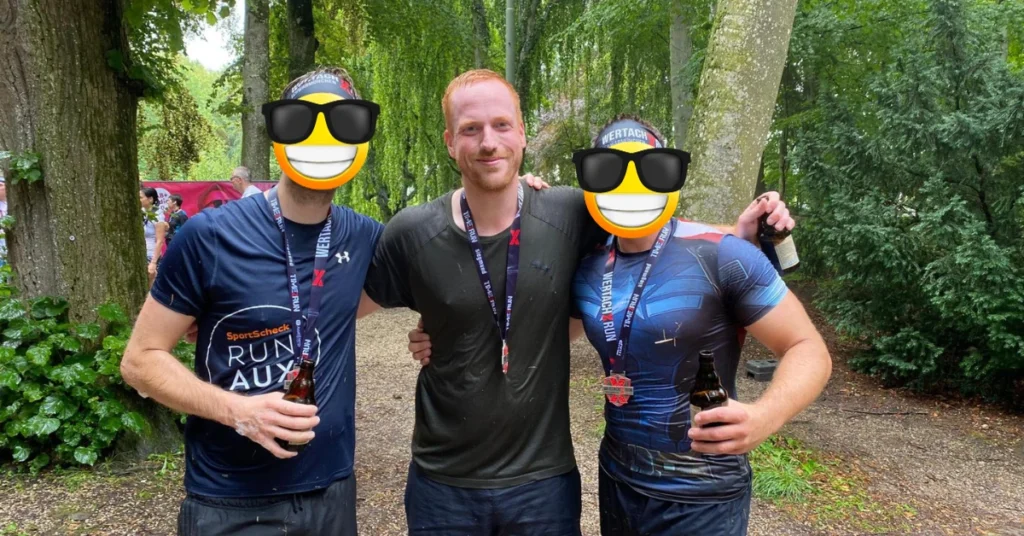In the fitness world, there’s always a debate between slow jogging vs fast walking. As we know, cardio exercise is a crucial component for a healthy lifestyle. However, deciding which one is right for us can sometimes be challenging. We’re here to help you understand the differences and similarities, so you can make an informed choice for your workouts.
So what are we waiting for – let’s go. OK, I’ll show you the differences between slow jogging vs fast walking.
Pro´s:
- ✅ Elastic sleeve cuffs
- ✅ Breathable
- ✅ Stretchy and durable
Con:
- ❌ No thick material
Defining the Terms
🏃♂️ What Is Slow Jogging?
Slow jogging, as the name suggests, is a form of jogging where we maintain a comfortable pace without pushing ourselves too hard. It lies somewhere between a walk and a faster run, with a focus on maintaining a steady rhythm. This type of jogging usually has a pace of around 4-6 km/h, which is easily attainable by most people, especially beginners.
To emphasize the low-impact nature of slow jogging, we can employ a soft landing technique while jogging, where our feet make minimal noise and less force is transmitted through our joints. This way, we can reap the cardiovascular benefits of jogging without causing excessive strain on our body.
Some benefits of slow jogging include:
- ✅ Improved endurance
- ✅ Lower impact on joints
- ✅ Increased fat-burning potential

“The important thing is that you start. No matter how. You’ll get faster and more stamina on your own over time. Every day you do nothing, you are choosing against your health (except on rest days, of course)”
🚶♂️ What Is Fast Walking?
Fast walking, also known as power walking or speed walking, is a method of walking that involves maintaining a brisk pace. Unlike jogging or running, one foot remains on the ground at all times, and the arms are usually swung vigorously, providing added momentum. Fast walking typically has a pace of about 4-6 km/h, which is the same as that of slow jogging.
To engage in fast walking, it’s important to maintain proper posture and technique.
Here are a few tips for effective fast walking:
- ✅ Stand tall, with shoulders relaxed
- ✅ Keep your core engaged
- ✅ Bend your arms at a 90-degree angle
- ✅ Use a quick, short stride
Much like slow jogging, fast walking boasts an array of health benefits, such as:
- ✅ Improved cardiovascular fitness
- ✅ Enhanced mood
- ✅ Increased calorie burn
Both slow jogging vs fast walking provide similar benefits, and the best choice between the two depends on personal preference, comfort, and physical abilities. Whichever way we choose to stay active, it’s vital to keep it consistent and enjoyable.
Health Benefits of Slow Jogging Vs Fast Walking

🫁 Cardiovascular Health
Both slow jogging vs fast walking provide significant benefits for cardiovascular health. Engaging in these activities can help improve overall heart function and contribute to a decreased risk of heart disease. We can experience a reduction in blood pressure, resting heart rate, blood sugar, and cholesterol levels, all contributing factors to improved cardiovascular health.
⚖️ Weight Management
When it comes to slow jogging vs fast walking, both have their advantages. Slow jogging typically burns more calories than fast walking, due to the energy expenditure involved in running. However, fast walking can still be an effective way to manage weight, as it burns a considerable amount of calories too.
Calories burnt per 30 minutes*:
- ✅ Slow jogging: 250-300 calories
- ✅ Fast walking: 180-200 calories
*Note: Values are approximate and may vary depending on individual factors like weight, pace, and fitness level.
🏋️ Joint Impact and Injury Prevention
- Fast walking, or power walking, is a lower impact activity than jogging, making it a better option for individuals with joint concerns or those aiming to reduce the risk of injury.
- Slow jogging, despite its impact, can promote stronger bones and muscles, ultimately contributing to better joint health.
Exercise Efficiency

🔥 Calories Burned
When comparing slow jogging vs fast walking, it’s essential to consider the number of calories burned during each activity. Slow jogging tends to be more effective in burning calories, as it requires more energy compared to fast walking. For example, a study indicates that slow jogging can burn more calories while keeping a consistent pace. This makes it a more efficient choice when it comes to losing weight.
⏰ Time Commitment
- Both slow jogging vs fast walking can be performed within similar timeframes, allowing individuals to meet the U.S. government’s recommendations of 150 minutes of moderate-intensity aerobic activity per week or 75 minutes of vigorous-intensity aerobic activity per week.
- Slow jogging, due to its higher calorie burn in the same amount of time, may be perceived as more time-efficient, particularly for individuals with weight loss goals, as long as the required intensity levels are maintained.
💪 Intensity and Perceived Effort
- Both slow jogging vs fast walking are considered moderate-intensity aerobic activities, capable of raising heart rate and improving cardiovascular fitness.
- Slow jogging typically increases heart rate more than fast walking, resulting in a slightly more challenging workout due to the higher perceived effort.
Physical and Mental Well-being

🧠 Mental Health Advantages
- Engaging in slow jogging vs fast walking releases endorphins, contributing to mood enhancement and stress reduction, thus offering mental health benefits.
- Regular physical activity, including outdoor activities like slow jogging and fast walking, can boost self-esteem, improve mental health, and provide a refreshing break from technology, fostering a connection with nature and surroundings.
🌟 Improving Overall Health
- Both slow jogging vs fast walking offer numerous health benefits, including improved cardiovascular health, muscle strengthening, and increased endurance.
- A study found that slow jogging expends twice the energy of walking at the same speed, despite similar perceived effort.
- Slow jogging places different pressures on joints and activates various muscle groups, while fast walking tends to put less strain on joints and works muscles differently, indicating the importance of trying both exercises to determine the best fit for individual preferences and fitness goals.
Some ways to make these exercises more enjoyable and engaging include:
- ✅ Track our progress using a fitness app
- ✅ Explore new walking or jogging routes
- ✅ Include interval training in our routine
- ✅ Join a local group or find a workout buddy for motivation
By incorporating slow jogging vs fast walking into our daily routines, we can reap the numerous benefits, such as improved mental health and overall fitness, while enjoying the great outdoors.
Biomechanical Aspects
🏃♂️ Body Mechanics During Exercise
- When comparing slow jogging vs fast walking, it’s important to consider their biomechanical differences, which impact muscle activation and joint pressure.
- Slow jogging results in approximately double the energy expenditure compared to walking at the same speed, despite similar perceived effort, due to differences in ground reaction force and center of gravity shifts.
- Fast walking involves a lower center of gravity and a more controlled motion, placing less stress on the joints compared to slow jogging.
🚶♂️ Pace and Motion Analysis
Understanding the biomechanical effects of gait speed can help us make informed decisions about our exercise routines. The speed at which we walk or jog has a significant impact on factors such as joint kinematics, muscle activity, and spatiotemporal gait parameters.
| Exercise | Speed | Steps | GRF | Muscle Activation |
|---|---|---|---|---|
| Slow Jogging | Moderate | Longer | Higher | Increased |
| Fast Walking | Comparable | Shorter | Lower | Varied |
As we can see from the table above, slow jogging usually involves a higher ground reaction force, longer strides, and increased muscle activation compared to fast walking.
Lifestyle Integration

🏞️ Incorporating into Daily Life
Integrating slow jogging vs fast walking into our daily life is an easy and effective way to maintain a healthy lifestyle. We can take a few minutes during our lunch breaks, join a group for morning or evening strolls, or even walk or jog to run errands.
To keep ourselves going, we can use various strategies such as:
- ✅ Setting daily step goals: Aiming for a specific number of steps per day (e.g., 8,000 or 10,000) encourages us to be more active throughout the day.
- ✅ Tracking progress: Using a fitness tracker or smartphone app helps keep track of our progress, providing motivation towards our fitness goals.
- ✅ Walk or jog with a friend: Exercising with someone makes it more enjoyable and creates a sense of accountability.
⚖️ Balancing with Other Fitness Activities
A well-rounded exercise routine should include a mix of strength training, cardiovascular exercise, and flexibility workouts. Slow jogging and fast walking mainly target cardiovascular fitness, but we cannot neglect other aspects of our physical well-being.
Here’s a sample schedule for incorporating slow jogging or fast walking with other fitness activities:
| Monday | Tuesday | Wednesday | Thursday | Friday | Saturday | Sunday |
|---|---|---|---|---|---|---|
| Slow Jogging or Fast Walking | Strength Training | Rest Day | Slow Jogging or Fast Walking | Strength Training | Flexibility Workout (e.g., Yoga) | Rest Day |
Comparative Analysis
🏃♂️ Pros and Cons of Slow Jogging
✅ Pros:
- ✅ Endorphins: Slow jogging releases endorphins, which are known to improve mood and create a sense of well-being.
- ✅ Lower impact on joints: Since slow jogging has a lower impact on the hips and knees, it may be a better option for people with joint issues or those who are prone to injuries.
- ✅ Accessible: Slow jogging is a gentle form of exercise, making it suitable for beginners and older adults who may struggle with high-intensity workouts.
❌ Cons:
- ❌ Technique-based: Some people may find it challenging to maintain the proper jogging technique at a slow pace, which may lead to injuries or discomfort.
🚶♂️ Pros and Cons of Fast Walking
✅ Pros:
- ✅ Low impact: Fast walking has even less impact on the hips, knees, and other joints than slow jogging, making it an ideal exercise for those with joint concerns or recovering from an injury.
- ✅ No special technique required: Fast walking is more natural and doesn’t require mastering any specific technique, as it is an extension of regular walking with increased speed.
- ✅ Accessible for various fitness levels: Like slow jogging, fast walking is also suitable for beginners and older adults or those who prefer not engaging in high-intensity exercise.
❌ Cons:
- ❌ Limited endorphin release: The release of endorphins may be lower in fast walking compared to slow jogging, which might make it less rewarding for some people seeking the “runner’s high.”
- ❌ Less development of running-specific muscles: Fast walking doesn’t incorporate the same muscle groups as jogging or running, which might be a disadvantage for those aiming to improve their running skills or overall athletic performance.
Incorporating both slow jogging and fast walking into your fitness routine can offer various benefits, such as the release of endorphins and a lower impact on your hips and other joints.
Tailoring to Individual Needs

💪 Fitness Level Considerations
When we are making the decision between slow jogging vs fast walking, it’s important to consider our current fitness levels.
- For beginners, fast walking offers a low-impact option to enhance cardiovascular fitness and heart health while minimizing joint stress, making it suitable for individuals starting their fitness journey.
- Slow jogging provides a slightly higher intensity, offering a challenge for endurance and aiding in the adaptation to increased cardiovascular demands, contributing to the development of a stronger heart and lungs.
🔄 Recovery and Adaptation
- Both slow jogging vs fast walking contribute to improving cardiovascular fitness, but it’s crucial to prioritize adequate rest and recovery as we adapt to new exercises and training routines.
- Personal motivations and fitness goals should also be considered when determining the preferred exercise. Slow jogging may be favored for enhancing heart health and endurance, while fast walking could be more suitable for injury prevention and joint health.
In terms of recovery, here is a basic comparison between slow jogging and fast walking:
| Exercise | Intensity | Recovery Time | Impact on Joints |
|---|---|---|---|
| Slow Jogging | Moderate | 24-48 hours | Moderate |
| Fast Walking | Low | 12-24 hours | Low |
Practical Tips and Strategies
🏁 Getting Started
When beginning a new fitness routine, it’s important to find the right balance between intensity and sustainability. Slow jogging vs fast walking both offer heart-strengthening and calorie-burning benefits, making them a goldilocks choice for new fitness enthusiasts.
To get started, we recommend the following:
- ✅ Choose your preferred activity: Whether you prefer slow jogging or fast walking, the key is to find an activity that you enjoy and feel motivated to do consistently.
- ✅ Start slowly: Initially, aim for 5-10 minutes of steady pace, gradually increasing the duration over a few weeks.
- ✅ Protect your joints: If you have a history of joint problems, fast walking might be a better option, as it has a lower impact on your joints.
- ✅ Dress appropriately: Opt for comfortable clothing and footwear for a “plainclothes workout” experience.
🔄 Maintaining Consistency
A consistent routine is crucial for reaping the life-extending and immune-boosting benefits of slow jogging vs fast walking. The following tips can help you stay on track:
- ✅ Schedule your workouts: Assign dedicated time slots for your workout sessions and stick to them.
- ✅ Stay motivated: Remind yourself of the many health benefits, such as improved blood sugar and cholesterol levels, that come with consistent exercise.
- ✅ Find a workout buddy: Having a partner or joining a group can help you stay accountable and committed to your routine.
📈 Tracking Progress
Monitoring your progress can be motivating and helps you identify areas for improvement. Here are some ways to track your progress:
- ✅ Set goals: Establish specific, achievable, and time-bound goals, such as walking or jogging for 30 minutes, 4 times a week.
- ✅ Use fitness apps: There are numerous apps available for tracking your pace, distance, and time during your workouts.
- ✅ Record your achievements: Maintain a fitness journal or use online tools to log your workouts and track your progress over time.
By incorporating these practical tips and strategies into your fitness routine, we can all experience the immense health benefits of slow jogging and fast walking.
Our Opinion on Slow Jogging vs Fast Walking


In our experience, both slow jogging vs fast walking offer great benefits to our overall health. Each of these exercises has something unique to bring to the table, and we think it’s valuable to incorporate both into our fitness routine where possible.
Slow Jogging:
- Ideal for those who enjoy a more leisurely pace and want to build their cardiovascular health.
- Can help to improve respiratory fitness and reduce stress levels.
- Typically performed at a pace of around 3 to 5 miles per hour.
- May feel more natural to those with a running background.

“Our favorite aspect of slow jogging: We love that slow jogging allows us to enjoy the outdoors and take in the scenery while still getting a decent workout.”
Fast Walking:
- Often called “power walking,” this exercise targets leg muscles and improves posture.
- Works well for those looking to improve their strength and stamina without the impact of running.
- Can be less intimidating and more accessible for people who are new to exercise or recovering from injuries.
- Usually done at a pace similar to slow jogging, but with less impact on joints.

“Our favorite aspect of fast walking: We appreciate the lower impact nature of fast walking, making it a fantastic option for individuals with joint concerns or who may be hesitant to try jogging.”
An effective way to incorporate both exercises into our routine is by alternating between them. For example, we might do slow jogging on Mondays and Thursdays and fast walking on Tuesdays and Fridays, while taking rest days on Wednesdays, Saturdays, and Sundays. This variety not only keeps us engaged but also maximizes the different health and fitness benefits we can achieve from these activities.
FAQ
What is your option for Slow Jogging vs Fast Walking? I would love to hear it in the comments. I’m sure you also like reading about How Many Steps in a Marathon or Half Marathon Calorie Burn.



